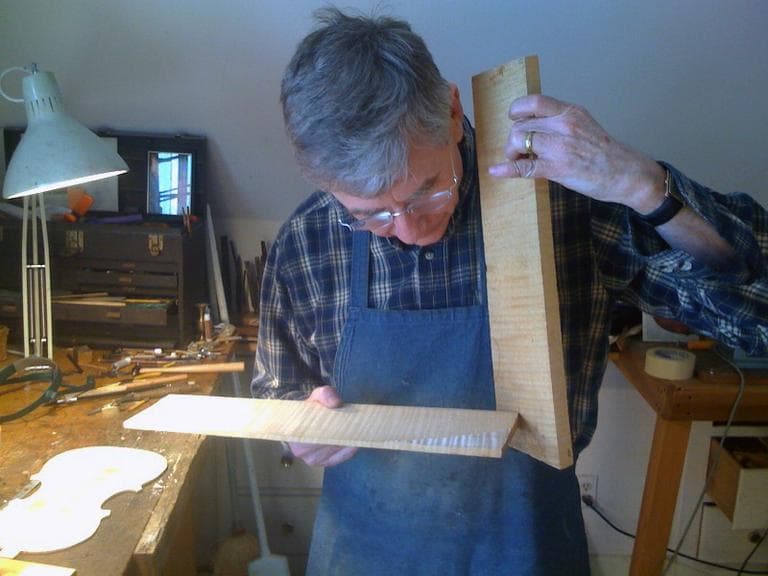Advertisement
Bob Childs Makes Violins That Sound 'Chocolaty'
Resume
For 26 years, Bob Childs has been making violins in his home in Cambridge. You can see his instruments in the hands of everyone from the nation's top Irish fiddlers to classical masters in the Boston Symphony Orchestra.
About once a year, Childs gathers many of the musicians who play his instruments to perform together in an eclectic group he calls Childsplay. The fiddling extravaganza is the subject of a new concert documentary, "Childsplay: Live at the Somerville Theatre."
I visited Childs in his workshop, to find out what makes his instruments so special.
Finding Perfection
From a high shelf in his third floor workshop off Garden Street, Childs pulled down small planks of air-dried wood. Whenever a customer orders a violin, Bob starts by tapping the planks together, to get a sense of how they'll resonate as part of a finished instrument.
"Here's a couple of taps," Childs said as he held two planks at a perpendicular angle and gently beat them together.
“There are schools of violin-making that rely very much on machinery and measurements. But my instruments… I’m certainly of the intuitive school.”
Bob Childs
Tap tap tap
"You're listening for a bell-like sound, where the sound just goes and keeps going," Childs said as a dull tone rang from the wood. "You can hear that the sound is already in the instrument."
Childs pulled a different set of planks from the shelf.
Tap tap tap
The tone from these two pieces of wood was noticeably lower.
"This already to me has a sound that puts the violin into a darker range," Childs said. "'Chocolaty' as some people say."
I asked Childs how he knows that a low pitch in the wood will result in a dark sound in the finished violin.
"Well, I've made a lot of violins," he said, as he picked up a third set of wood.
Tap tap tap
The pitch from these planks rang quite a bit higher.
"But it still has a beautiful ring," Childs said. "It has a really nice sustain."
Childs hand carves six to eight violins to order each year. At $15,000 a pop, he makes a decent living, though a lot of that goes into wood cut from high altitude trees in Europe. (Trees up there grow more slowly in the cold, thin air, so the rings form closer together.) When assembled into a finished violin, the wood that sings the best gives the longest sustain.
"It just keeps resonating, that's the beauty of it," Childs said as he tuned up a finished violin.
He strummed the open strings, and the sound took a full eight seconds to die away.
"That's what you want," Childs said. "That sense of, sort of, very slight decay as the notes are fading away."
A Master At Work
Childs has been carving violins for 35 years, and he looks like it. On the day I visited Childs, his hands looked like the wood he was working — knotted and striating as he dragged a knife around the pencil outline of a violin back.
"You know, a lot of this is done by eye," Childs said. "There are schools of violin-making that rely very much on machinery and measurements. But my instruments... I'm certainly of the intuitive school."
As a result, Childs' instruments have an idiosyncratic sound, which he describes as "dark and chocolaty."
"Unlike, say, a violin that's more like a trumpet, that's out in front of the orchestra, my violins tend to be a kind of a beautiful sound that the ear is drawn towards," Childs explained.
The common DNA of Bob's instruments is easy to hear in Childsplay, comprised of many of Bob's customers from through the years.
"It's like a family that sings together," Childs said. "There's a familial tone."
At the end of "Childsplay: Live at the Somerville Theatre," there's a moment when all of the players have exited the stage, leaving their instruments behind. In the film, Childs describes it as a family reunion.
"You create the violin, it takes a couple hundred hours to do it. And then you have to let it go," Childs told me. "But like children, they come back home and you keep your eye on them, make sure they're doing good."
Childs often sees his "children" once a year for minor repairs or maintenance checks. But the real reunion happens when he sees them in the context of Childsplay.
"We get to play music together. There's just a deeper sense of community that comes out of that," Childs said.
More:
- The concert documentary "Childsplay: Live at the Somerville Theatre" has its premiere screening at the Brattle Theatre Sunday at 3.
This segment aired on March 9, 2011.